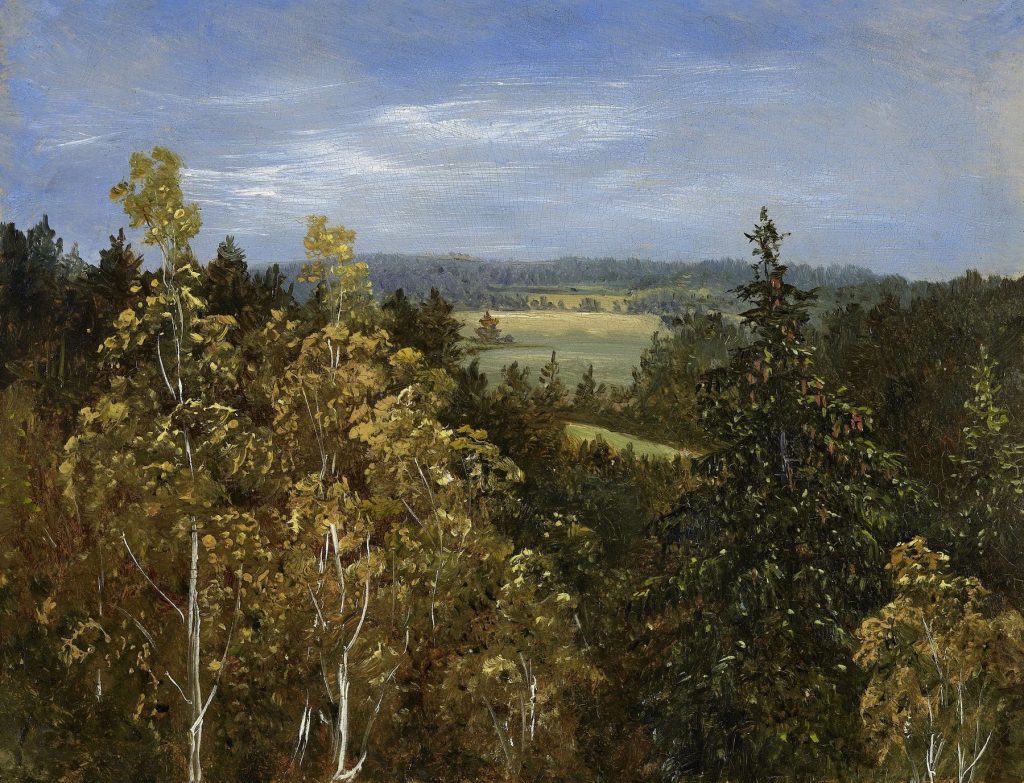Carl Gustav Carus (Leipzig 1789 - 1869 Dresden)
A Landscape Glimpsed between Autumn Woods, c.1830
Oil on board
15 x 19 cm
Provenance:
Pfarrer Rietschel, Leipzig, 1968 (according to Prause)
The Dietze Collection, Bremen
Literature:
Elisabeth Bülck, Carl Gustav Carus. Sein Leben und sein Werk im Verhältnis zu Caspar David Friedrich und dessen anderen Schülern betrachtet, unpublished diss., Greifswald 1943, no 248
Marianne Prause, Carl Gustav Carus. Leben und Werk, catalogue raisonné, Berlin 1968, p.170, no. 386, repr.
Carus is one of the outstanding figures of the age of Goethe. A man of many talents, he was active as a physician, a natural scientist, a man of letters as well as being a painter of the first rank. He played a prominent role in the German Romantic movement both as an artist and as an author of important theoretical writings. His Briefe zur Landschaftsmalerei are regarded as of seminal importance in the understanding of early nineteenth-century thinking about art.[1]
Marianne Prause ascribes the present oil study to a small group of studies of wooded landscapes datable on stylistic grounds to around 1830.[2] All the studies in this group are executed on paper or board and they all share a similar, small format – a feature that emphasizes their intimate character. Another common feature is the use of a compositional device – ‘a sample of nature experienced at close quarters’[3] set in the foreground of the landscape. In the present study Carus lays particular emphasis on the contrast between the delicately defined branches of the silver birches and the dense, dark green mass of the conifer to the right. His studies differ in the main from the finished paintings worked up in the studio in his use of broader brushwork, a greater compositional freedom and more random choice of motif. The studies of similar subjects dated by Prause to the period after 1835 appear sketchier and seem to display a greater interest in purely colouristic effect.[4]
It is in his landscape sketches that Carus reveals himself as a painter in tune with the latest artistic developments of his time.[5] As early as the mid-1820s he had begun to produce oil sketches of the landscapes around Dresden – probably motivated by the oil studies of Johan Christian Dahl. Dahl’s innovative work in the landscape genre was to inspire an entirely new approach to landscape painting in nineteenth-century Germany. Carus’s own theoretical writings on landscape painting dating from the same period emphasize the importance of studying nature. In letter no. 8 of his Briefe zur Landschaftsmalerei, written in 1824, he bemoans the neglect of the study of nature in the academies, attributing it to early learning of a particular style such as is acquired by diligently copying the landscape scenes and paintings of other artists.[6] He calls for landscape painters to place greater focus on the inner laws determining the structure of a plant or a mountain. In another letter he proposes that landscape painters should remember to retain a certain respect for God’s nature and in doing so, may succeed in producing works of a beauty more exalted, more significant than those painted by Claude and Ruisdael. These landscapes will be pure images of nature, but nature, viewed with a spiritual eye, will appear in the form of a higher reality.[7]
Carus was born in Leipzig in 1789. His father was the owner of a dye factory. He enrolled as a student of medicine at the University of Leipzig in 1806. During his medical studies he attended in his free time the Academy of Arts where Friedrich August Tischbein and Hans Veit Schnorr von Carolsfeld were professors. He completed his studies in medicine at Leipzig University in 1811 with a doctorate and qualified as a university lecturer. He was appointed Professor of Gynaecology at the Medical-Surgical Academy in Dresden in 1814. Carus’s œuvre is indebted to the enduring artistic influence of Caspar David Friedrich, a close friend from 1817 onwards. Carus’s work is also indebted to the influence of Johan Christian Dahl. Carus was to distance himself from Friedrich’s influence in the late 1820s, going on to develop a more personal form of artistic expression. He continued to practise medicine and in 1827 was appointed personal physician to the Saxon royal family. As Royal Physician he was in Rügen and the Riesengebirge. He travelled in Italy, England and Scotland and was also in Paris. He met Goethe in Marienbad in 1821 and the two men shared a long-standing friendship. This friendship is recorded in their correspondence. Carus died in Dresden in 1869.
[1] See Carl Gustav Carus, Zehn Briefe und Aufsätze über Landschaftsmalerei mit zwölf Beilagen und einem Brief von Goethe als Einleitung, 1815-35, Leipzig and Weimar 1982. [2] Prause, op. cit. , nos. 384-387. [3] Gerd Spitzer, in Carl Gustav Carus. Natur und Idee, exhib. cat., Dresden, Staatliche Kunstsammlungen and Berlin, Staatliche Museen, June 2009 - January 2010, Dresden and Berlin 2009, p.206. [4] Prause, op. cit., nos. 357, 358, 394. [5] Prause, op. cit., p.52f. [6] [(das) zeitige Erlernen einer gewissen Manier und zwar durch stetes Kopieren der Landschaftsszenen und Gemälde anderer Künstler.] Carl Gustav Carus, Neun Briefe über Landschaftsmalerei, geschrieben in den Jahren 1815-1824. Leipzig 1831, p.105 (letter no. 8). [7] [(vergisst nicht eine) gewisse Ehrfurcht Andacht vor der göttlichen Natur sich zu bewahren (..., dann) werden einst Landschaften höherer, bedeutungsvollerer Schönheit entstehen, als sie Claude und Ruisdael gemalt haben, und doch werden es reine Naturbilder sein, aber es wird in ihnen die Natur, mit geistigem Auge geschaut, in höherer Wahrheit erscheinen.] Carl Gustav Carus, op. cit., p.93 (letter no. 6).

